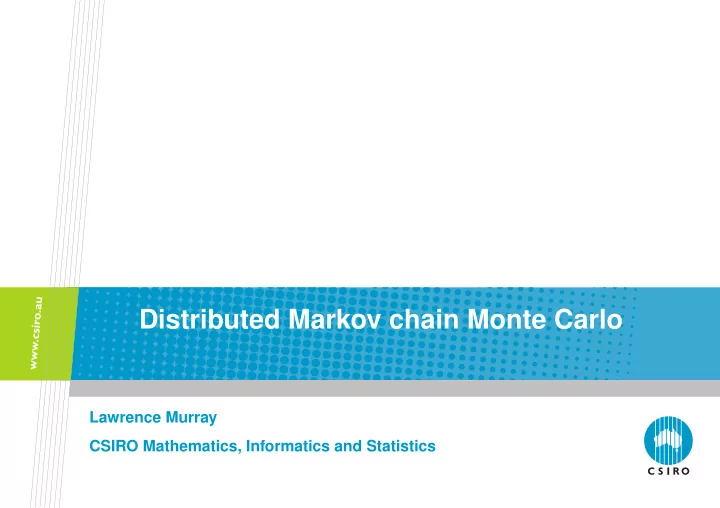

Distributed Markov chain Monte Carlo Lawrence Murray CSIRO Mathematics, Informatics and Statistics
Motivation • Bayesian inference in environmental models. • Particle Markov chain Monte Carlo (PMCMC): – state-space model, – Metropolis-Hastings over p ( Θ | y 1: T ) , – use particle filter to estimate marginal likelihoods: � ∞ p ( y 1: T , x 1: T | θ ) d x 1: T −∞ • Particle filters executed on GPU, but evaluations still take several seconds, may require several minutes for larger models. • Scale up to cluster level, one Markov chain per CPU-GPU pair. Lawrence Murray Slide 2 of 7
Quasi-ergodicity and multiple chains p(X) p(X) p(x) Starting distribution Estimate by single quasi-ergodic chain Estimate by ensemble of quasi-ergodic chains x x x p ( X ) is the target distribution, consisting of two isolated modes; (left) the starting distribution; (centre) typical posterior returned by a single quasi-ergodic chain; (right) typical posterior returned by multiple quasi-ergodic chains. Lawrence Murray Slide 3 of 7
Convergence and multiple chains If some portion ρ of steps, 0 < ρ ≤ 1 and typically up to . 5 , must be removed as burn-in from each chain, the maximum clock-time speedup through parallelisation is limited to 1 /ρ (Amdahl’s law). Thus, a multiple-chain strategy must also reduce ρ as the number of chains increases in order to scale well. Lawrence Murray Slide 4 of 7
Method For each chain i , consider a proposal that mixes some local component l i ( θ ′ i | θ i ) with a remote or global component R i ( θ ′ i ) : q i ( θ ′ i ) := (1 − α ) l i ( θ ′ i | θ i ) + αR i ( θ ′ i ) , R i ( · ) can be constructed via some contributed component r j ( · ) from each chain j . Consider: C R i ( θ ′ j =1 r j ( θ ′ i ) ∝ max i ) . Importantly, R i ( · ) can be adapted asynchronously as new information is received from other chains. Faults only deprive chains of timely adaptation, they do not impact correctness. Lawrence Murray Slide 5 of 7
Early results 6 Random walk Adaptive Mixture, without sharing Mixture, with sharing 5 4 R p 3 2 1 0 5000 10000 15000 20000 25000 0 5000 10000 15000 20000 25000 0 5000 10000 15000 20000 25000 0 5000 10000 15000 20000 25000 R p statistic of Brooks & Gelman (1998) across steps Evolution of the ˆ for each method, with (left to right) 2, 4, 8 and 16 chains. Lines indicate mean across 20 runs, and shaded areas a half standard deviation either side. Lawrence Murray Slide 6 of 7
CSIRO Mathematics, Informatics and Statistics Lawrence Murray Phone: +61 8 9333 6480 Email: lawrence.murray@csiro.au Web: www.cmis.csiro.au Contact Us Phone: 1300 363 400 or +61 3 9545 2176 Email: enquiries@csiro.au Web: www.csiro.au
Recommend
More recommend